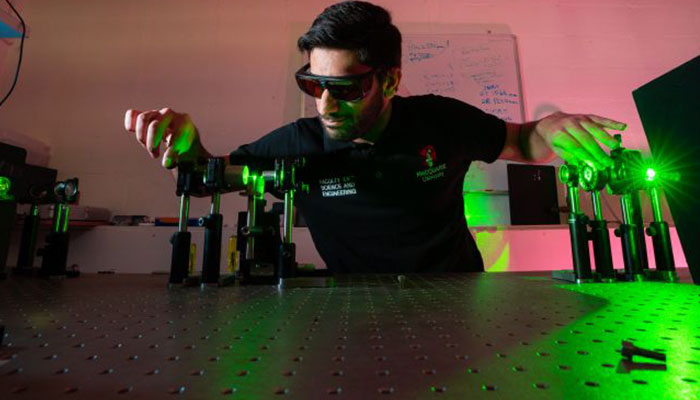Scientists at Macquarie University’s Photonics Research Centre are using diamonds to generate encoded light pulses that behave in a way that cannot be predicted.

Diamonds are a cryptographer's best friend: quantum properties of diamonds can create truly random secure keys for encrypted information.
Truly random numbers are a vital resource used by cryptographers and digital security experts to secure communications in critical industries such as banking and finance.
The problem is that most events we consider random; like the flip of a coin or the spin of a roulette wheel, only appear random because we lack information to predict the outcome. Quantum processes, on the other hand, are guaranteed by the laws of physics to be genuinely random – no information exists until the event we want to predict has already taken place.
Using this idea of genuine randomness, the researchers designed a diamond laser system where each laser-light pulse generated has a polarisation direction determined by the quantum motion of the carbon atoms in the diamond lattice – the arrangement of carbon atoms and their bonds.
Random polarisations are often used to distribute encoded passwords and keys. Currently, randomness is often taken from an external source, like the timing of radioactive decay event for example, and mapped onto the laser polarisation in a two-step process. This diamond device eliminates the need for this second step, avoiding extra infrastructure and improving security.
Unpredictable atomic vibrations
In an article just published in Optics Express, the researchers show that diamond, when configured as a laser, is able to generate a random polarisation state directly from what’s called the quantum “zero-point” motion of the carbon atoms in the diamond lattice. This motion arises from quantum vibrations of the atomic lattice, which are inherently random and therefore impossible to predict.
Diamond is crucial to this scheme in two key respects. First, the particular symmetry of the diamond lattice is critical. The authors show that for one particular direction through the crystal, the carbon atoms are arranged in a way that creates a delicately-balanced operating point (an unstable equilibrium) that is then upset by their zero-point motion to seed a new random polarisation each time the laser is pulsed.
Second, the carbon atoms are extremely tightly bound, allowing the quantum zero-point motion to dominate at room temperatures. Other materials need to be cooled to cryogenic temperatures, so this is a tremendous advantage for implementing the source.

Innovation: Macquarie Photonics researcher Seyed Abedi aligns the diamond to produce laser pulses with quantum-randomized polarization direction.
“This is an entirely new tool for producing quantum randomness” says Dr Doug Little, the lead researcher on the project. “We are hoping this type of device will provide end-users in fields such as encryption and quantum simulation with a new option for simplifying and enhancing their technology.”
“A fascinating aspect of this laser is that the degree of randomness can be tuned by tweaking the orientation of the diamond. In future, this will allow us to study the transition from quantum randomness to classical determinism in a systematic manner; which could have implications that go beyond lasers and their applications.”
Dr Doug Little is a physicist at the Macquarie Photonics Research Centre in the Department of Physics and Astronomy.
Please Explain: How does Quantum cryptography use photons
to securely transmit data?
Why are random polarisations important? One application relates to the distribution of authentication keys used to transmit encrypted data.
A beam of photons can be polarized in all directions at once – diagonally, vertically or horizontally, for example. Light in this state is unpolarised. Filters can align unpolarised light exclusively in a single direction, making it polarised. The same filters can be used by receivers to measure the incoming polarisation.- One well-known key distribution scheme encodes bits (0’s and 1’s) into photons’ polarisation state. Vertical and diagonal polarisations are assigned 1’s for example, and horizontal and anti-diagonal polarisations are assigned 0’s.
- To evade eavesdroppers, the receiver randomly chooses to prepare each photon with the filter in the vertical/horizontal arrangement or the diagonal/anti-diagonal arrangement. The receiver communicates back to the sender which filter arrangement was used to measure each bit, and the sender responds whether each arrangement was correct or not. Bits measured in the correct arrangement are kept and converted into a secure key while the others are discarded.
- This protocol is theoretically secure because an adversary attempting to detect the transmitted polarisation sequence cannot do so without disrupting the statistics of the random polarisations. The other communications made between sender and receiver relate only to the arrangement of filters, which do not reveal the specific photons that were received.



